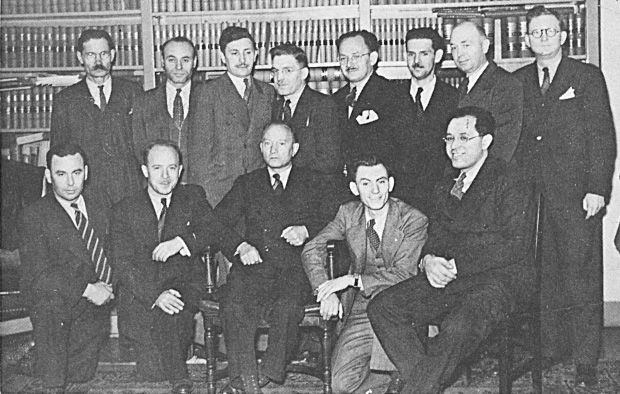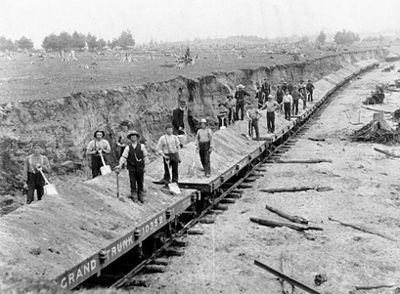The Candy Bar Protest, also known as the Five Cent War, Candy Bar War, Candy Bar Strike, or the Chocolate Candy Bar Strike, was a protest that took place in the spring of 1947. Children in numerous Canadian cities organized public protests or boycotts against the rise of chocolate bar prices (see Confectionery Industry). The protest was generally well-received by the Canadian public, but it fell apart after unsubstantiated allegations that the effort was backed by communists. (See also Communist Party of Canada.)

Causes
On 24 April 1947, the price of chocolate bars was raised from five cents to eight cents. Chocolate bar manufacturers argued that the price increase was a consequence of rising production costs. In addition, manufacturers argued that the increase was caused by the loss of wartime contracts and the removal of price controls, which had been in effect throughout the Second World War. (See also Wartime Prices and Trade Board; Confectionery Industry)
On 25 April 1947 in Ladysmith, British Columbia, a group of children made their way to the Wigwam Café, a popular local confectionery and lunch counter. The children discovered that the cost of chocolate bars had jumped up by 60 per cent overnight and with no advance warning. Children and teens in Ladysmith were the first youths in Canada to lead protests against the increase of chocolate bar prices. The price increase was significant, given that children of the era rarely earned more than a dollar in allowance. (See also Wage and Price Controls.)
Spread of the Protests
Within a few days, the strike had spread to other Canadian cities. In Victoria, British Columbia, about 200 children marched on the provincial legislature on 29 April 1947. The same day in Edmonton, approximately 300 children held a “buyers strike,” or boycott to discourage people from buying the more expensive chocolate bars. In Ottawa, a group of 10 buglers led about 60 children on a march on Parliament Hill, while in Toronto 500 teenagers from several high schools marched down Bloor Street and converged on Christie Pits Park. Other demonstrations were held in Burnaby, Winnipeg, Montreal, Calgary, Quebec City and in different cities in the Maritimes (see Maritime Provinces). In some cases, police were called in to break up the demonstrations.
In certain areas, the striking children had earned the support of student councils and the unions of various schools. Parents across Canada were generally supportive of the striking youths. Community groups helped the striking children by printing their signs, standing in solidarity with them and bringing them snacks. The rapid increases in prices on a wide variety of consumer goods was a major shock to Canadians in the immediate post-Second World War period (see Second World War; Wage and Price Controls). Concerns about overcharging for consumer goods were widespread. Some 3,000 “anti-eight-cent-candy-bar” pledge cards were distributed to Canadian youth to show that they would support the total boycott of chocolate bars until the five-cent price was returned. It was estimated that sales of chocolate bars dropped by as much as 80 per cent during the strike.
Pushback & Cold War Hysteria
The strikes generated considerable national attention. The National Federation of Labor Youth took an interest in the cause and helped organize a Toronto rally that took place on 2 May 1947. Meanwhile, chocolate and candy bar manufacturers attempted to tell their side of the story by taking out full-page advertisements in Toronto newspapers. Manufacturers argued that price increases were the result of a combination of new federal taxes, increased labour costs and the price of cocoa and sugar. (See also Taxation in Canada; Wage and Price Controls)
Did you know?
The National Federation of Labor Youth was the new name for the Young Communist League of Canada, which had been banned by the government in 1940. (See also Communist Party of Canada.)
The protest movement was derailed after the Toronto Telegram published a sensationalist story on 3 May 1947. The newspaper story quoted an unnamed source, indicating that the protest had been appropriated by communists. Without providing concrete evidence, the article strongly suggested that communists were using the strike to sow chaos in Canadian society and to indoctrinate Canada’s youth in Marxism. The Financial Post published a similar story, running a front-page headline reading “Communists run candy bar strike, recruit young children for parade.”
In a 2012 interview with The Globe and Mail, Parker Williams, one of the leaders of the original protest in Ladysmith, British Columbia, said that the Ladysmith protest was a spontaneous effort driven by the realization that youths did not have to accept the increase of chocolate bar prices and that they had the power to protest.
Despite the lack of evidence of communist infiltration, in the context of the early Cold War the allegation was sufficient to derail the protest movement in early May 1947. Following the protests, the price of candy bars would fall to seven cents, but subsequent price increases did not result in a similar protest movement.
Legacy
While the Candy Bar Protest dissolved, the children’s public organizing has been portrayed in film and art. The protests are the subject of a documentary entitled The Five Cent War. A mural commemorating the protesting children was installed in Chemainus, British Columbia in 2017 (see North Cowichan). The events are also described in the children’s books Maggie and the Chocolate War (2007) and Candy Bar War (2021).

 Share on Facebook
Share on Facebook Share on X
Share on X Share by Email
Share by Email Share on Google Classroom
Share on Google Classroom







